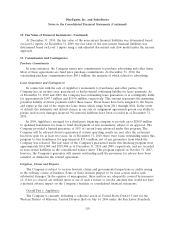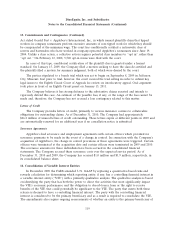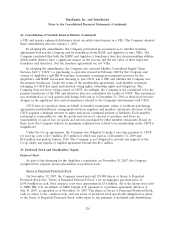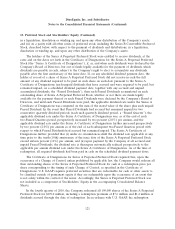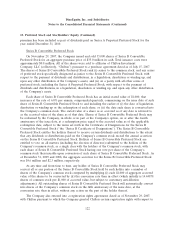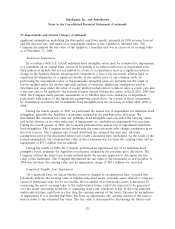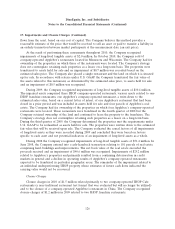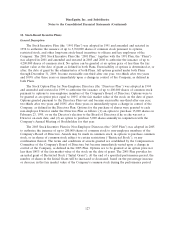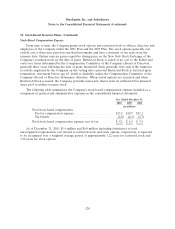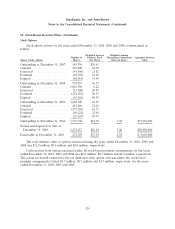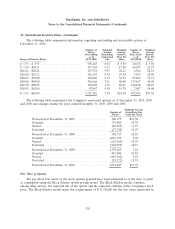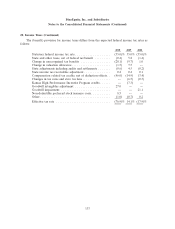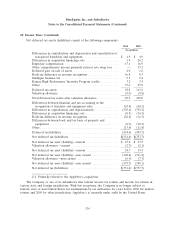IHOP 2010 Annual Report Download - page 142
Download and view the complete annual report
Please find page 142 of the 2010 IHOP annual report below. You can navigate through the pages in the report by either clicking on the pages listed below, or by using the keyword search tool below to find specific information within the annual report.DineEquity, Inc. and Subsidiaries
Notes to the Consolidated Financial Statements (Continued)
17. Impairments and Closure Charges (Continued)
flows from the asset, based on our cost of capital. The Company believes this method provides a
reasonable estimate of the price that would be received to sell an asset or paid to transfer a liability in
an orderly transaction between market participants at the measurement date (an exit price).
At the result of performing these assessments throughout 2010, the Company recognized
impairments of long-lived tangible assets of $2.0 million. In October 2010, the Company sold 63
company-operated Applebee’s restaurants located in Minnesota and Wisconsin. The Company had fee
ownership of the properties on which three of the restaurants were located. The Company’s strategy
does not contemplate retaining such properties as a lessor on a long-term basis. The properties were
transferred to assets held for sale and an impairment of $0.7 million was recorded based on the
estimated sales price. The Company also placed a single restaurant and the land on which it is situated
up for sale. In accordance with criteria under U.S. GAAP the Company transferred the fair value of
the assets related to this restaurant, as determined by the estimated sales price, to assets held for sale
and an impairment of $0.5 million was recognized.
During 2009, the Company recognized impairments of long-lived tangible assets of $10.4 million.
The impaired assets comprised three IHOP company-operated restaurants, various assets related to one
IHOP franchise restaurants, one Applebee’s company-operated restaurant, a write-down to the
estimated sales value, based on a current letter of intent, of one Applebee’s restaurant that had been
closed in a prior period and was included in assets held for sale and four parcels of Applebee’s real
estate. The Company had fee ownership of the properties on which four Applebee’s company-operated
restaurants were located. These restaurants were franchised in the fourth quarter of 2008 but the
Company retained ownership of the land and continued to lease the property to the franchisee. The
Company’s strategy does not contemplate retaining such properties as a lessor on a long-term basis.
During the third quarter of 2009, the Company determined the properties met the requirements under
U.S. GAAP to be reclassified as assets held for sale. The properties were written down to the estimated
fair value that will be received upon sale. The Company evaluated the causal factors of all impairments
of long-lived assets as they were recorded during 2009 and concluded they were based on factors
specific to each asset and not potential indicators of an impairment of long-lived assets as a whole.
During 2008 the Company recognized impairments of long-lived tangible assets of $71.4 million. In
June 2008, the Company entered into a sale-leaseback transaction relating to 181 parcels of real estate
comprising land, buildings and improvements. The net book value of the real estate exceeded the
proceeds received and an impairment of $40.6 million was recognized. Impairments of $29.2 million
related to Applebee’s properties and primarily resulted from a continuing deterioration in credit
markets in general and a decline in operating results of Applebee’s company-operated restaurants
expected to be franchised in particular geographic areas. The remainder of the impairment related to
an individual underperforming IHOP property whose estimates of future cash flows indicated the
carrying value would not be recovered.
Closure Charges
Closure charges in 2010 of $1.5 million related primarily to two company-operated IHOP Cafe
restaurants (a non-traditional restaurant test format that was evaluated but will no longer be utilized)
and to the closure of a company-operated Applebee’s restaurant in China. The Company recognized
closure charges of $1.2 million in 2009 related to two IHOP franchise restaurants.
126




